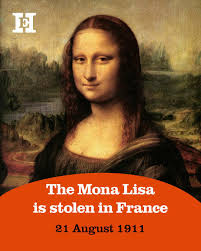The Infamous Theft of the Mona Lisa: A Historic Art Heist

Introduction
The Mona Lisa, painted by Leonardo da Vinci in the early 16th century, is one of the most famous works of art in the world. Its allure and mystique have drawn millions to the Louvre in Paris, where it is housed. However, the painting’s history became even more intriguing in 1911, when it was stolen from the museum, sparking an international manhunt and media frenzy. The theft was not just a crime; it altered the perception of art theft and underscored the Mona Lisa’s monumental status in the art world.
The Theft of the Mona Lisa
On August 21, 1911, an Italian handyman named Vincenzo Peruggia, who had previously worked at the Louvre, executed a meticulously planned heist. Disguised as a museum employee, he hid overnight in the museum and made off with the iconic painting, which he concealed under his smock. Peruggia believed that the Mona Lisa belonged in Italy rather than France and was determined to return it to its rightful home.
News of the stolen Mona Lisa sent shockwaves through Paris and beyond. Investigators launched extensive searches, but for over two years, the painting remained missing. The media was captivated, with numerous theories and sensational stories emerging about its whereabouts and the motives behind its theft.
The Painting’s Recovery
In December 1913, Peruggia was apprehended after he attempted to sell the painting to an art dealer in Florence, Italy. After its recovery, the Mona Lisa was returned to the Louvre, where it was declared a national treasure of France. The theft significantly enhanced the painting’s fame; it became a symbol of cultural heritage and the lengths to which individuals would go to protect art.
Conclusion
The theft of the Mona Lisa remains one of the most infamous art heists in history, highlighting not only the vulnerabilities of art preservation but also the painting’s overwhelming cultural impact. It led to increased security measures in museums worldwide and generated interest in the stories behind famous artworks. Today, the Mona Lisa stands as a testament to the enduring power of art and the complex relationships between nations and their cultural treasures.









